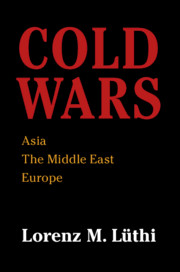Book contents
- Cold Wars
- Cold Wars
- Copyright page
- Dedication
- Contents
- Maps
- Acknowledgments
- Note on Names, Transliterations, and References
- Abbreviations
- Introduction
- 1 From High Imperialism to Cold War Division
- Part I Elusive Unities
- Introduction to Chapters 2 to 4
- 2 The United Kingdom and the Arab League
- 3 The Soviet Union and the Socialist Camp
- 4 The United States and the Free World
- Part II Asia
- Part III The Middle East
- Part IV Alternative World Visions
- Part V Europe between the Superpowers
- Part VI European Détente
- Part VII The End of the Regional Cold Wars
- Notes
- Index
2 - The United Kingdom and the Arab League
from Part I - Elusive Unities
Published online by Cambridge University Press: 19 March 2020
- Cold Wars
- Cold Wars
- Copyright page
- Dedication
- Contents
- Maps
- Acknowledgments
- Note on Names, Transliterations, and References
- Abbreviations
- Introduction
- 1 From High Imperialism to Cold War Division
- Part I Elusive Unities
- Introduction to Chapters 2 to 4
- 2 The United Kingdom and the Arab League
- 3 The Soviet Union and the Socialist Camp
- 4 The United States and the Free World
- Part II Asia
- Part III The Middle East
- Part IV Alternative World Visions
- Part V Europe between the Superpowers
- Part VI European Détente
- Part VII The End of the Regional Cold Wars
- Notes
- Index
Summary
With the collapse of the Ottoman Empire at the end of World War I, the United Kingdom considered the Middle East the linchpin to maintain its control over its imperial possessions around the Indian Ocean. In the interwar period, if fortified control through the mandate system of the League of Nations, turned on its imperialist partner France in 1945 to gain exclusive influence, and supported the creation of the Arab League during WW II. Originally, during the 1930s, the United Kingdom had rejected the idea to create an Arab organization as a threat to its imperial interest, but eventually supported it as the best option to secure its long-term strategic objectives. Yet, British support for the creation of a Jewish homeland in Palestine since WW I, its endorsement of the creation of Israel after WW II, its involvement in creating anti-Soviet alliances in the early 1950s, and finally its imperialist attempt to regain direct control in the Middle East during the Suez Crisis undermined its political and military sway. Afterwards, the Arab League emerged as an organization unaffiliated with any great power from outside of the region, although it remained internally split until 1964.
Keywords
- Type
- Chapter
- Information
- Cold WarsAsia, the Middle East, Europe, pp. 42 - 67Publisher: Cambridge University PressPrint publication year: 2020

